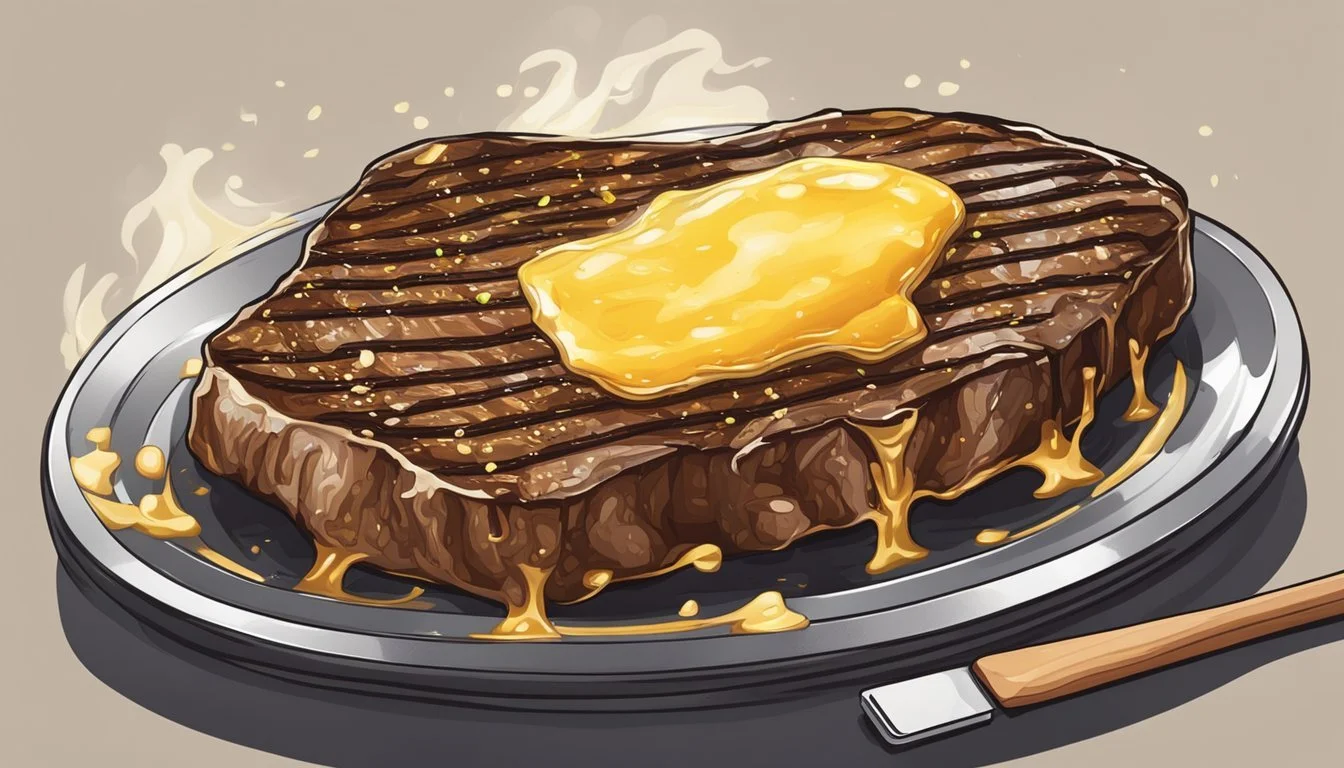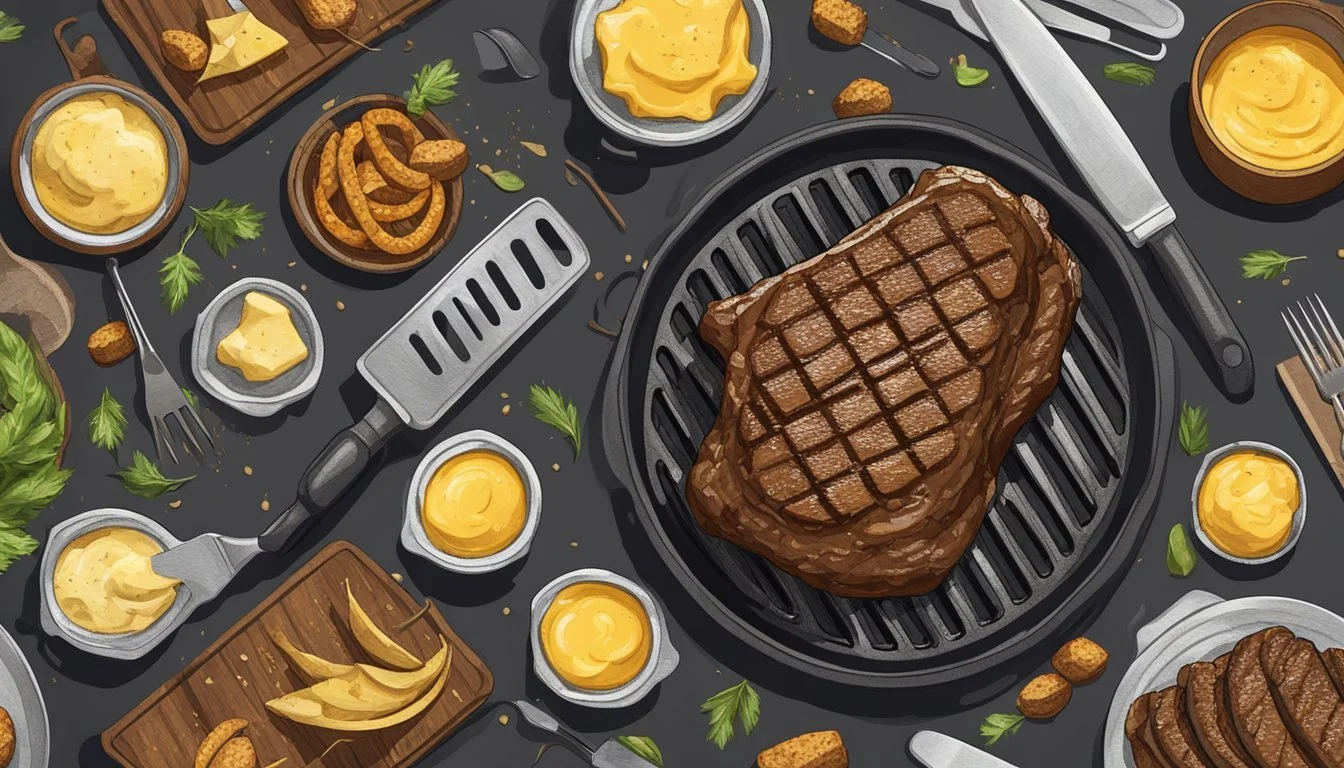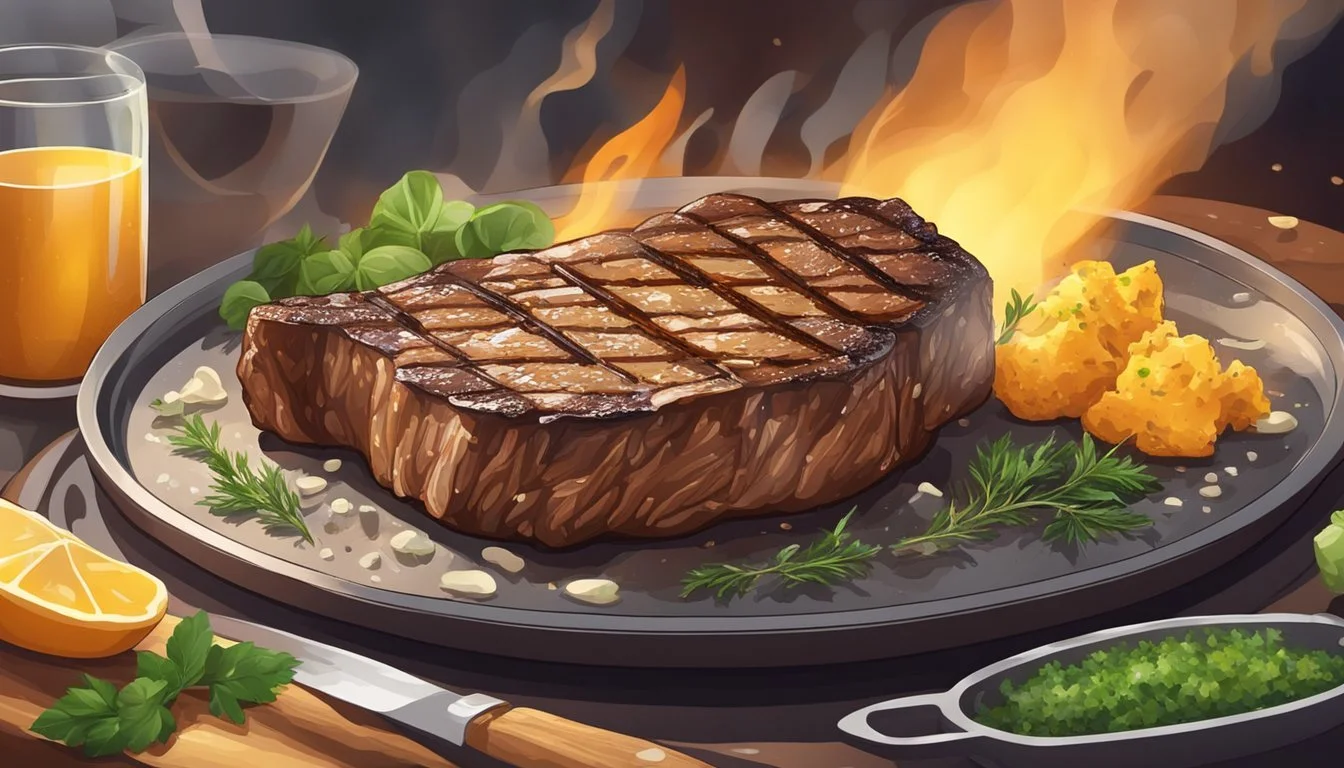Cowboy Butter Steak
The Ultimate Flavor Experience for Grill Enthusiasts
Steak enthusiasts continually seek new ways to enhance the flavor experience of their favorite cuts, and cowboy butter offers a delectable twist on the classic grilled steak. It blends the rich, succulent flavors of a well-cooked steak with the bold and aromatic cowboy butter, a compound butter that is a symphony of garlic, herbs, and a kick of heat. This culinary creation is becoming a staple for cooks looking to elevate grilled meats (What wine goes well with grilled meats?) from good to exceptional.
The origins of cowboy butter can be traced back to the rustic cooking of cowboys over open flames, where simple ingredients were transformed into something extraordinary. The contemporary version of this butter incorporates ingredients like lemon zest, crushed red pepper flakes, and fresh herbs, providing a vibrant contrast to the savory depth of a beautifully grilled ribeye or sirloin. When the butter melts onto the hot steak, it creates a harmonious blend of flavors that enhances the meat's intrinsic richness.
Preparing the perfect cowboy butter steak involves letting the meat rest to absorb all the flavors after being grilled to the desired doneness, before it’s topped with a generous dollop of the prepared butter. The result is a steak that promises a mouthwatering experience with every bite, boasting a crusty char on the outside while remaining tender and juicy on the inside, perfectly complemented by the golden, flavorful melt of cowboy butter.
The Essentials of Cowboy Butter Steak
Cowboy Butter Steak combines the rich flavor of quality beef with the savory kick of a seasoned butter blend. This fusion brings together the best of grilling and gourmet to transform a simple steak into an unforgettable meal.
Selecting Your Steak
For the best Cowboy Butter Steak, ribeye is a top choice due to its generous marbling, which contributes to a juicier and more flavorful steak. The New York strip is another excellent option, known for its balance between tenderness and flavor. Sirloin can also be used for a leaner cut but may not provide the same level of juiciness. When selecting steak, one should always look for a good amount of marbling and a bright, red color indicative of freshness.
Understanding Cowboy Butter
Cowboy Butter is a type of compound butter, which means it's butter mixed with additional seasonings to enhance its flavor. The classic Cowboy Butter blend includes minced garlic, chopped parsley, fresh lemon juice, and Dijon mustard for a tangy touch. The aromatic fresh herbs and the spiciness of freshly ground black pepper create a rich flavor profile that amplifies the taste of the steak.
Gathering Ingredients
To prepare Cowboy Butter, the following fresh ingredients are essential:
Butter: The base of the compound butter, softened to room temperature.
Garlic: At least one garlic clove, finely chopped.
Lemon: Both lemon zest and lemon juice are used to provide a fresh zesty flavor.
Parsley: Fresh parsley, chopped, adds vibrant color and a mild herby edge.
Chives: These provide a mild onion-like essence.
Dijon Mustard: Adds a tangy heat that complements the steak.
Additional seasonings to taste, including kosher salt and freshly ground black pepper.
Optional add-ins to the Cowboy Butter can be shallots, prepared horseradish, thyme, or fresh thyme leaves and a dash of olive oil to help merge the flavors. Every ingredient serves a purpose to create a multi-dimensional flavor profile, majorly enhancing the steak experience.
Steak Preparation Techniques
Preparing the perfect steak revolves around mastering a few key techniques: creating an enviable sear, carefully monitoring internal temperature, and executing the proper resting and cutting of the meat.
Achieving the Perfect Sear
To achieve a delectable crust on a steak, high and direct heat is crucial. A cast-iron skillet or a hot grill grate is ideal for creating this sear. The reverse sear method—starting with a low-temperature oven or cooler side of a grill to slowly bring the steak to temperature before finishing with a high-heat sear—imparts a uniform cook and a flavorful crust. When using a skillet, ensure it's pre-heated; if grilling, steaks should be placed directly over the flames.
Preheat the cast iron skillet or grill grates before placing the steak.
Place steak on high heat for a short duration to form the crust.
For reverse sear, start on low temperature and finish on high.
Monitoring Internal Temperature
Internal temperature is the most accurate indicator of a steak's doneness. Rare typically registers at 120-130°F (49-54°C), medium-rare at 130-135°F (54-57°C), and medium at 135-145°F (57-63°C). Use an instant-read thermometer to check temperatures quickly without letting heat escape. Remember, the steak's temperature will increase slightly during resting.
Check with an instant-read thermometer.
Aim for 120-130°F for rare, 130-135°F for medium-rare, and 135-145°F for medium.
Doneness Temperature Range Rare 120-130°F Medium Rare 130-135°F Medium 135-145°F
Resting and Cutting the Meat
After the steak reaches the desired temperature, it must rest, typically on a cutting board, allowing the juices to redistribute. Covering loosely with foil can keep it warm during this time. Steaks should rest for approximately 5-7 minutes. When slicing, cut across the grain using a sharp knife to ensure tenderness.
Rest steak on a cutting board for 5-7 minutes, optionally cover with foil.
Pat dry with paper towel if there's excess moisture before cutting.
Cut across the grain to maintain tenderness.
Cooking with Cowboy Butter
Cowboy Butter offers a robustly flavored addition to steaks, amplifying the taste with its rich mixture of spices and herbs. As an ideal companion to grilled meats, especially steak, this compound butter is both a crowd-pleaser and an easy way to elevate a simple dish.
Making Cowboy Butter
To begin, Cowboy Butter is a type of compound butter, which means it is unsalted butter enhanced with various flavorings. One will need to cream the butter until it's fluffy and then blend in the essential components that define its characteristic profile: fresh chives, a bite from cayenne, black pepper, the tang of citrus zest and juice, and aromatic spices such as garlic powder.
Instructions:
In a bowl, combine:
1 cup of softened unsalted butter
2 tablespoons of minced fresh chives
1 teaspoon of cayenne pepper
Zest and juice of half a citrus (lemon or lime)
1 teaspoon of black pepper
1 teaspoon of garlic powder
Mix ingredients thoroughly until evenly distributed.
Grilling the Perfect Steak
For the perfect grilled steaks, timing and temperature are crucial. Whether one opts for a charcoal grill or a gas grill, aiming for a high heat of around 400°F is essential for creating a flavorful char. A grilled ribeye particularly benefits from this method, developing a tantalizing crust.
Grilling Steps:
Prep the steak: Allow the steak to come to room temperature, about 20–30 minutes before grilling, to ensure even cooking.
Season well: Right before grilling, generously season the steak with salt.
Grill: Begin by searing the steak on high heat for approximately 2 minutes per side.
Applying Butter to Steak
Once the grilled ribeye steak or any chosen grilled steak is cooked to the preferred level of doneness, it's time to apply the Cowboy Butter. Remove the steak from the grill and let it rest for a few minutes, allowing the juices to settle. Then, top the steak with a healthy dollop of the Cowboy Butter or apply a melted butter sauce daub carefully onto the steak, creating an irresistible combination of flavors.
Butter Application:
Rest: Remove steak from the grill and let it rest for 2-3 minutes.
Butter: Place a spoonful of the Cowboy Butter on top of the steak immediately after it comes off the grill—let the residual heat gently melt the butter.
When stored in the refrigerator, the Cowboy Butter can be kept in log form for easy slicing, or in a ramekin for spooning onto hot steaks. If preferred, one can use salted butter in the recipe, adjusting the seasoning to taste.
Side Dishes and Pairings
The right side dishes and pairings can elevate a cowboy butter steak to new culinary heights. Selecting complementary sides and beverages, while considering alternative meats, ensures a harmonious grilling experience.
Complementary Side Dishes
Cowboy Butter Steak pairs wonderfully with a variety of sides that can absorb its rich flavors or add a fresh contrast. Here are some top choices:
Potatoes: A classic choice, such as scalloped potatoes, provides a creamy and savory counterpoint. They are especially good at soaking up the cowboy butter.
Grilled Corn: The smokiness from grilled corn on the cob complements the charred flavors of the steak.
Salad: A crisp salad, possibly with a wedge of iceberg lettuce, adds a refreshing crunch and lightness.
Dinner Rolls: Fresh dinner rolls are perfect for mopping up any remaining cowboy butter on the plate.
Beverage Recommendations
Beverage pairings play a pivotal role in rounding out the meal:
Wine: A bold red wine, such as a Cabernet Sauvignon, enhances the steak's hearty flavors.
Beer: For those who prefer beer, an amber ale or a stout can stand up to the richness of the butter and charred meat.
Customizing for Other Meats
Cowboy butter isn't just for steak; it can be a versatile accompaniment to other meats:
Chicken: For grilled chicken, cowboy butter adds a depth of flavor that's both rich and satisfying.
Other Meats: This robust butter can also be paired with pork chops (What wine goes well with pork chops?) or lamb for a succulent twist.
Choosing the right sides and beverages while being open to different meat options can transform a simple grilled meal into a feast for the senses.
Tips and Tricks
With the right techniques, one can elevate the savory experience of Cowboy Butter Steak. This section will guide the reader through the processes of storing and reusing Cowboy Butter, as well as tips for enhancing the flavors and presentation of the dish.
Storage and Reuse of Cowboy Butter
Cowboy Butter should be stored properly to maintain its quality. After preparing the butter mixture with fresh herbs such as parsley and chives, along with other ingredients like lemon zest and horseradish, it can be transferred to a container or shaped using plastic wrap.
Storage: Place the butter in the refrigerator where it will solidify and can be kept for up to a week. For longer periods, the butter can be frozen.
Reuse: Cowboy Butter can be sliced as needed for each use, making it a versatile component that goes beyond steaks, enhancing vegetables and seafood.
Enhancing Flavors and Presentation
When it comes to the final presentation of the steak, Cowboy Butter takes center stage. To emphasize its robust flavor profile:
Fresh Herbs: Utilize freshly minced parsley and chopped chives for a burst of color and a more vibrant taste.
Lemon Zest: Add lemon zest sparingly to bring a refreshing citrus note that cuts through the richness of the butter.
Horseradish: Include a hint of horseradish to introduce a subtle heat that complements the succulence of the meat.
Presentation Tips:
Dollop: A well-shaped dollop of Cowboy Butter on top of the hot steak will melt tantalizingly, creating an appealing look and a delicious merger of flavors.
Slices: Alternatively, chilling the butter and cutting it into clean slices can provide a more refined presentation, with even melting over the steak.
Cowboy Butter Steak Variations
Cowboy butter steak can be a delightful dish with a customized twist, allowing for a wide range of flavors and cooking experiences. By experimenting with different spices and cooking methods, one can elevate this steak to new culinary heights.
Experimenting with Spices
In the realm of spices, paprika is a classic choice; however, for those seeking a deeper, smokier flavor, smoked paprika can introduce a subtle complexity to the cowboy butter. The addition of red pepper flakes can vary the heat profile, so adjusting the quantity can cater to individual heat preferences. For a robust flavor enhancement, incorporating Montreal steak seasoning can provide a pre-mixed variety of spices that complement the steak and cowboy butter harmoniously.
Paprika: Traditional or smoked for flavor depth
Red Pepper Flakes: Adjust quantity for desired heat level
Montreal Steak Seasoning: A pre-mixed option for robust flavor.
Alternative Cooking Methods
Beyond the traditional grilling, the reverse sear method can perfect a steak's internal cooking. By first cooking the steak slowly at a low temperature, then searing it on a high-heat surface, the steak can achieve an evenly cooked interior with a caramelized crust.
Gas Grill: Achieve consistent temperatures for reverse sear
Charcoal Grill: For those preferring a smoky taste, a charcoal grill can provide it, especially when combined with wood chips. Different types of wood chips, such as hickory or mesquite, can be added to the charcoal to infuse the steak with a unique smoky flavor.
By considering these spices and cooking methods, one can transform a simple cowboy butter steak into an array of tantalizing dishes that suit any palate or dining occasion.
Conclusion
The Cowboy Butter steak is a culinary delight, blending the richness of grilled ribeye with the robust flavors of cowboy butter. It's a straightforward recipe, delivering a taste that is both indulgent and balanced. The key lies in proper preparation and cooking techniques, including the resting period to ensure juiciness and flavor retention.
Preparation: Combining softened butter with ingredients like parsley, garlic, lemon zest, and spices yields the distinctive cowboy butter, which enhances the steak's flavor profile. The precision in mixing the butter compounds pays dividends in taste.
Cooking: Achieving a perfect sear on the ribeye, preferably on a grill, contributes to the steak's incredible texture. Suggested cooking methods, such as the reverse sear technique, can be effective in rendering a desirable crust with a tender interior.
Serving: Drizzling or placing a dollop of the cowboy butter on the hot steak allows it to melt, mingling with the meat's juices to create a rich and aromatic sauce. The impact of the butter's flavor is maximized when served immediately, fresh off the grill.
In essence, this dish represents a harmonious marriage of rustic tradition and culinary finesse. Chefs and home cooks alike can deliver an impressive dining experience with this combination, proving that simple ingredients can yield extraordinary results when executed with care and expertise.
References & Further Readings
For those keen on exploring the flavors of Cowboy Butter Steak further, a selection of resources can augment one's culinary journey. These references provide additional context, recipes, and insight into crafting this scrumptious dish.
Online Recipes:
Grilled Ribeye Steak (What wine goes well with ribeye steak?) with Cowboy Butter
The Ninja Cue provides precise steps and preparation tips for searing ribeye steaks and pairing them with cowboy butter. A great source for home chefs aiming to replicate restaurant-quality steak.
theninjacue.comGrilled Steaks with Cowboy Butter
Grill What You Love offers a detailed description of how to combine various herbs and spices to achieve the perfect cowboy butter blend, ideal for complementing grilled steaks.
grillwhatyoulove.com
Cookbooks:
Beef Recipes from the Grill: This comprehensive guide features a wide range of beef recipes, including inventive ways to enhance ribeye steaks.
Grocery Shopping Guides: Understanding the cuts of beef available at your local grocery store can make a significant difference in your grilling results. Look for marbling and thickness when selecting ribeye steaks to ensure optimal flavor and texture.
Restaurant Menus: Many steakhouses offer Cowboy Butter Steak, providing an opportunity to sample the dish before attempting it at home.
Complementary Sides:
Rice Dishes: A simple yet elegant companion to Cowboy Butter Steak, rice can be prepared in a variety of ways to complement the rich flavors of the beef.
Remember to visit respective websites or consult with cookbooks for further details and to ensure accurate replication of the recipes and tips provided.





